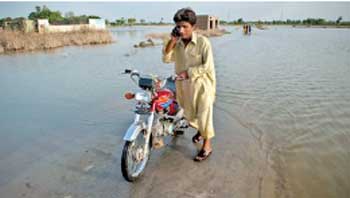Reply To:
Name - Reply Comment
Last Updated : 2024-04-26 10:47:00
 BY Erik Kjaergaard
BY Erik Kjaergaard
It’s time to mainstream disaster risk management in areas impacted by flooding in South Asia.
The monsoon season has again caused death and destruction across South Asia. As of this writing, more than 1,200 people have died in Bangladesh, India and Nepal. Flooding has damaged or destroyed schools and health facilities and forced millions to live in temporary shelters or relief camps. According to the UN, approximately 40 million people are affected.
This situation demands that we rethink our role in emergencies. In view of the scale of the disaster, a post-emergency credit from the Asia-Pacific Disaster Response Fund of US $ 3 million would only have limited effects.
The Asian Development Bank (ADB) support for early recovery and reconstruction—which could run into the hundreds of millions of dollars—would have bigger impact, including on risk reduction via build-back-better requirements. But even that would barely help to mitigate the damage.
A more substantive, long-term and sustainable response would be to mainstream disaster risk management (DRM) in areas impacted by flooding. ADB has past, ongoing and new projects in the pipeline – and the key question is how they factor in flood risk management in the short, medium and long term.
How, then, can we mainstream DRM across our country programmes, divisions and projects?
First, conduct a spatial analysis of the country programme and/or project. This consists of identifying which sectors, projects and/or activities take place in areas impacted by the current floods.
Spatial analysis can be done on a simple base map with cities and rivers—preferably also river basins and administrative borders—marked. Once the sectors and projects have been identified, we will know who has the potential to respond to the flood by smart programming.
Second, transition from hazard mapping to risk assessment. Mapping programme areas impacted by the current floods should ideally be expanded to a full-fledged risk assessment that goes beyond one-dimensional flood analysis by taking exposure (e.g. location of infrastructure and clients/beneficiaries) and vulnerability (e.g. design and maintenance of infrastructure as well as livelihood options of people) into consideration.
Apart from guiding DRM measures and safeguarding development investments, such analysis would provide accurate planning scenarios for future multi-hazard contingency planning.
Third, re-programme based on the risk assessment make our work more risk-informed and climate-smart. The importance of flooding and the specific vulnerabilities of beneficiaries would need to be analysed in relation to programme interventions.
The following parameters provide an analytical starting point for such interventions:
Geography. Rather than abandon flooded areas, we need to strengthen our efforts in the impact zone. The people who live here have the greatest development needs. They deserve infrastructure that can withstand future disasters, so it might be necessary to relocate and/or redesign existing and new infrastructure.
Beneficiaries. Focus on the most vulnerable population segments, which have least livelihood options when exposed to flooding. Women, children and elderly almost invariably have the greatest humanitarian needs. They also have often overlooked capacities to provide psychosocial support, and act as change agents in their communities.
Timing. Encourage governments to speed up efforts to mitigate the suffering of the affected population in flooded areas (e.g. public health campaigns to prevent water-borne diseases, social protection and livelihood support). Another way is to work with governments so they understand better the additional challenges that the floods pose so planned actives can stay on track or even proceed faster.
Approach. Consider new types of interventions, such as protecting critical infrastructure, incorporating DRM in training programmes and curricula, conducting specialized trainings for first responders and DRM and climate change awareness campaigns for beneficiaries.
Outreach. Reach out to often-overlooked population groups like socially excluded groups in terms of gender, caste, ethnicity, disability, household structure and children/adolescents out of school.
Whereas conventional targeting usually is based on development indicators only, risk assessment allows us to target interventions based on a combination of development indicators and natural hazards and climate change. This way, country programmes, sectors and projects become both risk-informed and climate-smart.
Admittedly, the scope of reprogramming varies depending on several factors including the planning/programming stage. However, it is possible to reprogram by going through the analytical process above.
In summary, we must stand ready to help. Up to now, DRM has often been interpreted as disaster response and recovery, rather than emergency preparedness and disaster risk reduction.
The fact that international donors provide generous funding for response and limited funding for preparedness and prevention does not help to reinforce risk reduction.
Tragically—and somewhat ironically—the message of disaster risk reduction tends to blossom in post-disaster situations and suffer when business-as-usual returns. It doesn’t need to be in this way. We know which areas are likely to be impacted by what natural hazards and we have no excuse not to act before new emergencies unfold.
(Erik Kjaergaard is Disaster Risk Management Specialist, South Asia Regional Department at Asian Development Bank)

Add comment
Comments will be edited (grammar, spelling and slang) and authorized at the discretion of Daily Mirror online. The website also has the right not to publish selected comments.
Reply To:
Name - Reply Comment
US authorities are currently reviewing the manifest of every cargo aboard MV
On March 26, a couple arriving from Thailand was arrested with 88 live animal
According to villagers from Naula-Moragolla out of 105 families 80 can afford
Is the situation in Sri Lanka so grim that locals harbour hope that they coul